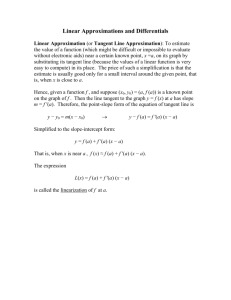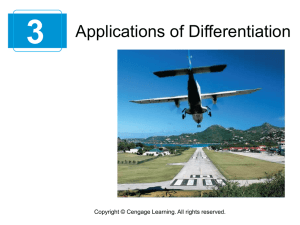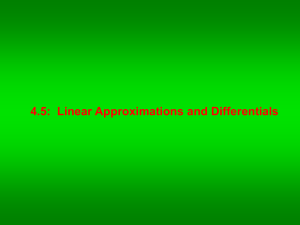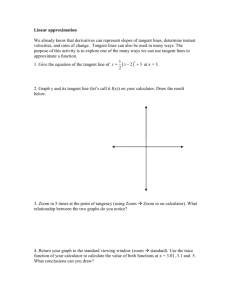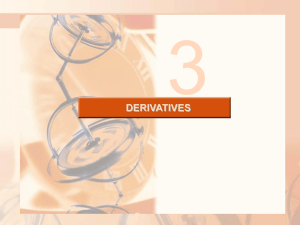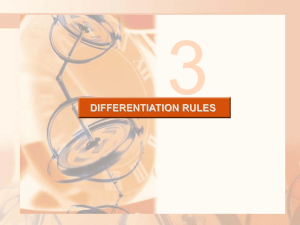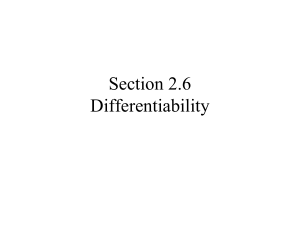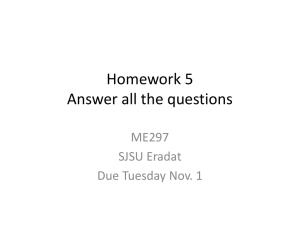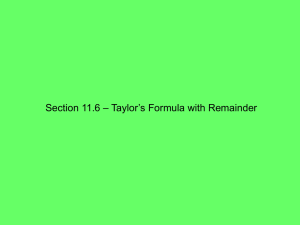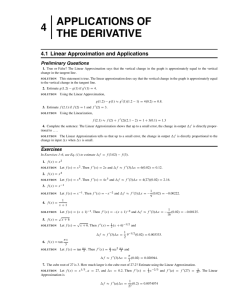Chapter 4.5
advertisement
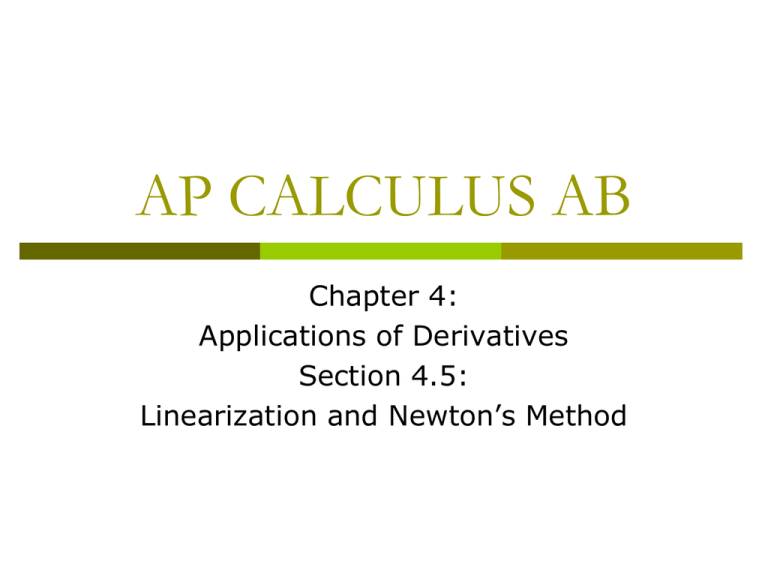
AP CALCULUS AB Chapter 4: Applications of Derivatives Section 4.5: Linearization and Newton’s Method What you’ll learn about Linear Approximation Newton’s Method Differentials Estimating Change with Differentials Absolute, Relative, and Percent Change Sensitivity to Change …and why Engineering and science depend on approximation in most practical applications; it is important to understand how approximation techniques work. Linear Approximation Any differentiable curve is “Locally Linear” if you zoom in enough times. Do Exploration 1: Appreciating Local Linearity (p 233) A fancy name for the equation of the tangent line at a is “The linearization of f at a” y – f(a) = f’(a)(x – a) Definition of Linearization If f is differentiable at x a , then the equa tion of the tangent line, L ( x ) f ( a ) f '( a )( x - a ), defines the lin earization of f at a . T he approxim ation f ( x ) L ( x ) is the stan d ard lin ear ap p roxim ation of f at a . T he point x a is the cen ter of the approxim ation. Just Math Tutoring You Tube What is Linearization? Just math tutoring Finding the Linearization at a point Followed by 25) Linear Approximation 10 minutes total time needed – Watch if you miss class this day or do not understand! Example 1 Finding a Linearization Find the linearization of f ( x ) 1 x at x = 0 (center of approximation) and use it to approximate 1 . 02 without a calculator. Then use a calculator to determine the accuracy of the approximation. Point of tangency f ‘(0) = L(x) = Equation of the tangent line: Evaluate L(.02) Calculator approximation? Approximation error: You try: Find linearization L(x) of f(x) at x = a when 3 f ( x ) x 2 x 3 and a = 2. How accurate is the approximation L(a + 0.1) ≈ f(a + 0.1) Point of tangency f(2) = Tangent Line equation: L(x) Evaluate |L(2.1) – f(2.1)| Approximation error: f ’(2) Example 2: Find the linearization of f(x) = cos x at x = π/2 and use it to approximate cos 1.75 without a calculator. Then use a calculator to determine the accuracy of the approximation. Point of tangency f (π/2) Tangent Line equation: L(x) f ’(π/2) Evaluate |L(1.75) – cos 1.75 by calculator | Approximation error: Example Finding a Linearization Find the linearization of f ( x ) cos x at x / 2 an d use it to approxim ate cos 1.75 w ithout a calculator. S ince f ( / 2) cos( / 2) 0, the point of tangenc y is ( / 2, 0). T he slope of the tangent line is f '( / 2) sin( / 2) 1. T hus L ( x ) 0 ( 1) x x . 2 2 T o approxim ate cos 1.75 f (1.75) L (1.75) 1.75 2 . Summary Every function is “locally linear” about a point x = a. If you evaluate the tangent line at x = a for points close to a, you will have a close approximation to the function’s actual value. Steps 1) Using f(x), find the equation of a tangent line at some point (a, f(a)). Find f(a) by plugging a into f(x). Find the slope from f’(a). L(x) = f(a) + f’(a) (x - a). 2) Evaluate L(x) for any x near a to get a close approximation of f(x) for points near a. Example 3: Approximating Binomial Powers using the general formula (1 x ) k 1 kx Use the formula to find polynomials that will approximate the following functions for values of x close to zero. a) 3 1 x b) 1 1 x How? Rewrite expression as (1 + x) k, Identify coefficients of x and k. Find L(x) = 1 + kx for each expression. c) 1 5x 4 d) 1 1 x 2 Example 4: Use linearizations to approximate roots. Find a) 123 and b) 123 3 Identify function: f(x) = x Let a be the perfect square closest to 123. Find L(x) at x = a. Use L(x) to estimate 123 Error? You try b. Differentials L et y f ( x ) be a differentiable function. T h e d ifferen tial d x is an independent variable. T he d ifferen tial d y is dy f '( x ) dx . (With dx as in independent variable and dy a dependent variable that depends on both x and dx.) Although Liebniz did most of his calculus using dy and dx as separable entities, he never quite settled the issue of what they were. To him, they were “infinitesimals” – nonzero numbers, but infinitesimally small. There was much debate about whether such things could exist in mathematics, but luckily for the early development of calculus it did not matter: thanks to the Chain Rule, dy/dx behaved like a quotient whether it was one or not. Example Finding the Differential dy Find the differential dy and evaluate dy for the given value of x and dx . y x 2 x , x 1, dx 0.01 5 dy 5 x 2 dx 4 dy 5 2 0.01 0.07 Example 6 Find the differential dy and evaluate dy for the given values of x and dx. How? Find f ’(x), multiply both sides by dx, evaluate for given values. a) y = x5 + 37x x=1, dx = 0.01 b) y = sin 3x x=π, dx = -0.02 You try: y 2x 1 x 2 , x 2 , dx 0 . 1 c) x + y = xy x=2, dx = 0.05 More Notation… dy dx df f ' ( x ) dx f '( x) dx f '( x) dx df f ' ( x ) dx Example 7 Finding Differentials of functions. Find dy/dx and multiply both sides by dx. a) d (tan (2x)) You try: d(e5x + x5) b) d( x x 1 ) Estimating Change with Differentials Suppose we know the value of a differentiable function f(x) at a point a and we want to predict how much this value will change if we move to a nearby point (a + dx). If dx is small, f and its linearization L at “a” will change by nearly the same amount. Since the values of L are simple to calculate, calculating the change in L offers a practical way to estimate the change in f. Differential Estimate of Change L et f ( x ) b e d ifferen tiab le at x a . T h e ap p ro x im ate ch an g e in th e valu e o f f w h en x ch an g es fro m a to a d x is d f f '( a ) d x . Estimating Change with Differentials Example Estimating Change with Differentials T he radius of a circle increases from a 5 m to 5.1 m . U se dA to estim ate the increase in the circle's area A. S ince A r , the estim ated increase is 2 dA 2 rdr 2 5 0.1 m 2 Example 8 The radius r of a circle increases from a = 10 to 10.1 m. Use dA to estimate the increase in the circle’s area A. Compare this estimate with the true change ∆A, and find the approximation error. Area formula for a circle: A = True change: f(10.1) – f(10) = Estimated change: dA/dr = dA = Approximation error: |∆A – dA| = You try: f(x) = x3 - x, a = 1, dx = 0.1 In Review: The linear approximation of a differentiable function f x at c is y f c f c x c because, from the slope of the tangent line y f c xc f c or y f c f c x c In Review Definition of Differentials: y f x is a differentiable function in an open interval containing x. The differential of x dx is any non-zero real number. The differential of y dy is dy f x dx Summary Linearization: The equation of a tangent line to f at a point a will give a good approximation of the value of a function f at a. The Linearization of (1 + x)k = 1 + kx Newton’s Method is used to find the roots of a function by using successive tangent line approximations, moving closer and closer to the roots of f if you start with a reasonable value of a. Differentials: Differentials simply estimate the change in y as it relates to the change in x for given values of x. We learned how to estimate with linearizations, differentials are simply a more efficient method of finding change. FYI – not tested Newton’s Method for approximating a zero of a function Approximate the zero of a function by finding the zeros of linearizations converging to an accurate approximation. Just Math Tutoring – Newton’s Method (7:29 minutes) Procedure for Newton’s Method 1. G uess a first approxim ation to a solu tion of the equation f ( x ) 0. A graph of y f ( x ) m ay help. 2. U se the first approxim ation to get a second, the second to get a third, and so on, using the form ula x n 1 x n f (x ) n f '( x ) n Procedure for Newton’s Method Using Newton’s Method U se N ew ton's method to solve x 3 x 1 0. 3 Let f ( x ) x 3 x 1, then f '( x ) 3 x 3 and 3 x n 1 x n 2 f (x ) n x 3x 1 3 x f '( x ) n 1 x n n 3x 3 n 2 n n A graph suggests that x 0.3 is a good firs t approxim ation. T hen, 1 x 0.3 1 x 0.322324159 2 x 0.3221853603 3 x 0.322185 3546 4 T he x for n 5 all appear to equ al x on the calculator. n T he solution to x 3 x 1 0 is about 0.322185354 6. 3 4
